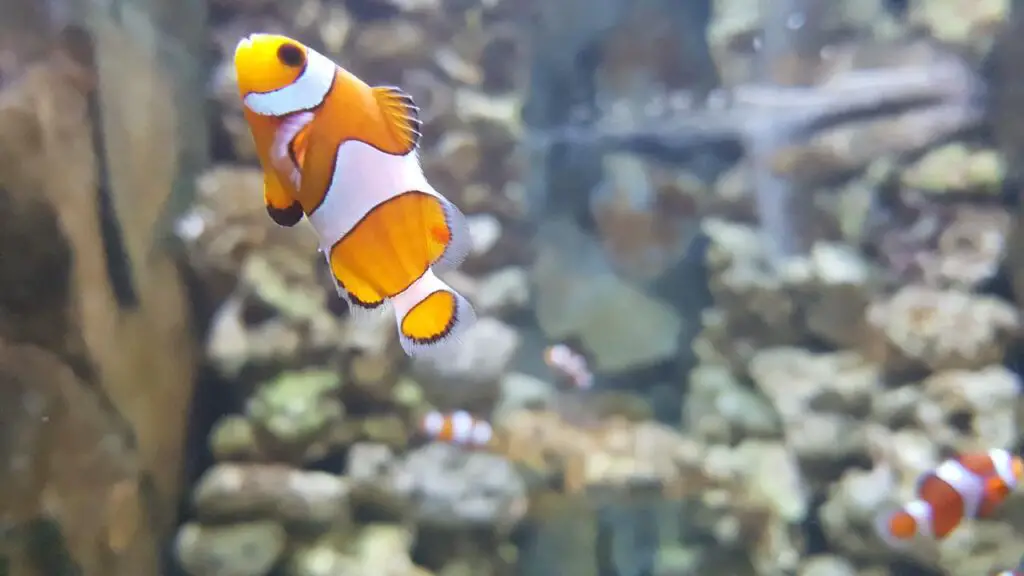Most people are familiar with Clownfish, thanks to a certain animated movie. Most people also know them to be bright, vibrant colors like orange, red, and yellow. But what if your Clownfish starts losing color? Turning white, even? Why does this happen to them?
There are many reasons Clownfish can lose their color and possibly even turn white. From nutrition to stress to disease, it can be hard to pinpoint the exact nature of the problem. Even so, there are some ways you can determine what the likely problem is.
If you find yourself in a situation where your Clownfish happen to be losing their color, don’t worry: we’ll discuss how and why this may be happening and what you can do about it.
Nutritional Concerns
Food can be a big part of why your Clownfish is losing its color, especially if you bought it from a pet store. You see, many pet stores feed their Clownfish with specially manufactured flakes that are designed to help boost their color (after all, more colorful fish tend to be bought more often).
If you cannot replicate this special food, chances are your Clownfish will lose a bit of color compared to when you first saw it at the pet store. However, this just means their color won’t be enhanced to the artificial level that it was at the pet store. If everything else is fine, the Clownfish should still be plenty colorful.
Water Conditions
Considering that a fish exists in water for its entire life, it should come as no surprise that the condition of the water plays a big role in how colorful your Clownfish are.
Many aspects of the water can cause a Clownfish to lose their color, including temperature, the pH balance, and the amount of ammonia in the water.
Make sure you do your research on the ideal environment for a Clownfish to live in, and ensure that your aquarium tank meets those parameters. If the water is too cold, the pH balance is off, or the ammonia level is too high, you can expect your Clownfish to lose some of its vibrancy, among other things.
Stress
Large amounts of stress is going to negatively affect your Clownfish in many ways. Unfortunately, there are many sources of stress for a fish, from living in a poor environment to getting too much light or even being bullied by other fish.
One way or another, you can expect your Clownfish to suffer in the color department if they are stressed out.
How Do You Tell if a Clownfish is Stressed?
It may seem difficult to determine whether or not a fish is stressed, but there are some signs you can look for to help you make this judgment. A stressed fish may have less appetite, and be eating less than usual. If they are diseased (which is obviously stressful) they may have bulging eyes, rotting fins, sores, or bloated stomachs.
Fittingly enough, loss of color is a potential indicator of stress. If you see your fish gasping at the surface of the water, this may also be a sign that the water is not oxygenated enough, causing stress in the fish.
Finally, if your Clownfish starts behaving much more differently than usual, such as swimming in odd patterns or becoming more aggressive, that can also be a sign.
Do Clownfish Turn Black When Stressed?
You may notice your Clownfish turning black over time. Don’t worry about this: it’s actually quite natural for a Clownfish to turn darker over the course of its life, and it is not an indicator that there is something seriously wrong. In fact, some species of clownfish are notorious for getting darker with age. One such species is the Ocellaris Clownfish.
There are many other species of Clownfish that naturally darken with time, though they may not turn outright black. It should also be noted that most species of Clownfish turn a darker shade when they use their female reproductive organs.
Clownfish are protandrous hermaphrodites, which mature as males but may reproduce as females, and they get darker when doing the latter.
So no, your Clownfish does not turn darker because of stress. It is turning lighter, which is often a sign of something being amiss. Another of the major causes of Clownfish growing lighter is disease.
What is Clownfish Disease?
A very common disease for marine fish is something known as Brooklynella, caused by a parasite. There are many symptoms, including gasping for air, lethargy, low appetite and more. It can cause stress in Clownfish, causing their color to degrade and become lighter. Brooklynella can even be deadly.
Thankfully, it can be treated with medication, the most common of which is formalin, which is a formaldehyde solution that has methanol added in. If you believe your Clownfish has Brooklynella, you should first consult with a veterinarian before taking any action.
How Can I Stop my Clownfish From Losing Color?
Always make sure the tank your Clownfish swims in is as clean as possible. You should check the filter, pH level, and temperature of your tank every day to make sure everything is right for a Clownfish’s ideal living environment.
You should also do bi-weekly partial water changes, replacing at least 15% of the tank’s water with fresh water.
Artificial aquarium lighting can affect Clownfish color, and lights that are too bright and too consistent can also cause stress for Clownfish. You should not only provide Clownfish with places to hide from the light in your aquarium but also limit their exposure to artificial light to eight hours a day at most.
Finally, the best food for keeping and enhancing Clownfish color includes carotene or astaxanthin. Breeders most commonly use this type of food to keep fish both healthy and vibrantly colored.
That being the case, you should consider using such food yourself if you feel that your Clownfish are not vibrant enough. Just make sure it is fitting food for them.


